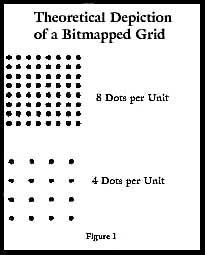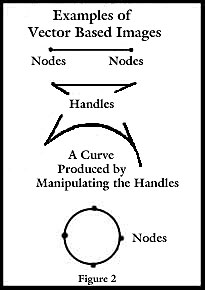|
While I wrote this article a few years ago for
a class I was teaching, I have found people still refer to
it. Thus, I am including it and updating it.
There are basically two types of graphic programs:
those that are bitmap based and those that are vector based.
The former comprise the image editing and painting programs
while the latter refer to the drawing programs. Programs such
as Adobe Photoshop, Corel PhotoPaint and Painter, Macromedia
Fireworks, etc. fall into the image editing and
painting category. CorelDraw, Adobe Illustrator, and
Macromedia Freehand are examples of vector based drawing programs.
Many programs, now, include tools for manipulating both types
of images.
 A
bitmap image is made up of pixels or bits (binary digits)
of information arranged on a grid. Each bit can be visualized
as a dot. The number of pixels per unit of measurement, example,
ppi (pixels per inch) or dpi (dots per inch) determines the
resolution of the image. These images are also referred to
as raster images (and, somewhat confusingly, bitmap images).
Simplistically, it could be stated that when one draws a line,
one is covering pixels. See figure 1. A
bitmap image is made up of pixels or bits (binary digits)
of information arranged on a grid. Each bit can be visualized
as a dot. The number of pixels per unit of measurement, example,
ppi (pixels per inch) or dpi (dots per inch) determines the
resolution of the image. These images are also referred to
as raster images (and, somewhat confusingly, bitmap images).
Simplistically, it could be stated that when one draws a line,
one is covering pixels. See figure 1.
 Vector
images are mathematical arrangements of points. These
points are connected by mathematical formulae. Thus these
images can be stretched and shrunk without changing the initial
quality of the image. Almost all of the images are made by
straight lines connected at nodes or points. However, one
can create a curve that is absolutely smooth. The nodes can
be manipulated to form smooth curves. The techniques involved
in drawing programs differ markedly from those used in painting
programs. See figure 2. Vector
images are mathematical arrangements of points. These
points are connected by mathematical formulae. Thus these
images can be stretched and shrunk without changing the initial
quality of the image. Almost all of the images are made by
straight lines connected at nodes or points. However, one
can create a curve that is absolutely smooth. The nodes can
be manipulated to form smooth curves. The techniques involved
in drawing programs differ markedly from those used in painting
programs. See figure 2.
Since vector images are represented by mathematical
formulae, they are resolution independent. This means that
one can make a 1" x 1" square and stretch it to
5" x 5" without losing any image quality. The information
is contained in the mathematical formula. If, however, one
did that with the same 1" square in a raster based program,
one would have to increase the number of pixels in the file.
Since each pixel carries color or black and white information
in it, the computer has to "decide"
how to increase the number of pixels. This is one of the reasons
why when one takes a web generated graphic at a screen resolution
of 72 dpi and tries to increase the resolution to 200 dpi,
for example, the colors can look awful. The computer had to
decide the color of the pixels that it added. This technique
of increasing the number of pixels in an image and keeping
the linear dimensions, inches for example, of the object the
same is called Resampling.
|
Original File at a Resolution of 72 dpi |
Same File Resampled
to a Resolution of 300 dpi |
| width = 100 pixels |
width = 417 pixels |
| height = 100 pixels |
height = 417 pixels |
| linear width = 1.389
inches |
linear width = 1.389
inches |
| linear height = 1.389
inches |
linear height = 1.389
inches |
| file size = 30 KB |
file size = 510 KB |
When the linear dimensions of a file are
changed, that technique is called Resizing. For example,
if one had a file that is 100 dpi and one increased the dimensions
without adding pixels, the number of pixels or dots
per inch, for example, would decrease. Conversely, if one
decreased the linear dimensions of a file and did not remove
pixels, the number of pixels or dots per inch would increase.
Often, one uses combinations of the above.
| Original File at a Resolution
of 72 dpi |
Same File Resized but
NOT Resampled to a Resolution of 300 dpi |
| width
= 100 pixels |
width = 100 pixels |
| height
= 100 pixels |
height = 100 pixels |
| linear
width = 1.389 inches |
linear width = .333 inches |
| linear
height = 1.389 inches |
linear height = .333 inches |
| file
size 30 KB |
file size = 30 KB |
In addition, the sizes of the files in a vector
based program will always be much smaller than in a bitmap
based program. Disregarding certain variables which are not
important for this comparison, one could draw in a vector
based program a 6" in diameter circle and fill it with
a color. The file size would be 152KB (kilobytes). If one,
then, exported the file as a TIFF file, which is a pixel based
format, the size at screen resolution which is 72 dpi (the
same as used for the web) would be 596 KB. If one had exported
the file at 300 dpi, the size would have been 10MB (megabytes).
|